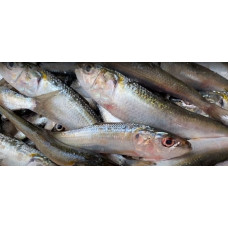Latin name
Sardinella longiceps
Other names
Sardinella longiceps
Identification
Body spindle-shaped, subcylindrical (its height usually less than 30% of the standard length), slightly compressed at the sides and covered with cycloid scales, head glabrous. The abdomen is rounded. There is a keel on the abdomen; it is not pronounced. This fish differs from all clupeids inhabiting the northern part of the Indian Ocean by the number of rays in the pelvic fin, equal to 8; from S. neglecta and S. lemuru by a longer head and a greater number of lower gill rays.
Features of fish fins
The dorsal fin is closer to the tail than to the head. The base of the pelvic fins is located below the center of the base of the dorsal fin. The dorsal fin has 16-18 rays; the anal fin has 14-16 rays; the pelvic fins have 9 rays.
Fish colouring
The dorsal surface of the body is bluish with a golden sheen, the sides and belly are silvery. The tail and dorsal fins are greenish-yellow, the rest is transparent.
Distribution
Occupies the northern Indian Ocean from the Gulf of Aden to Aldabra Island, off the southern coast of the Arabian Peninsula and the western and southern coasts of Hindustan, probably present in the waters of the Andaman Islands; not found in the Red Sea and Persian Gulf. These fish are found off Sri Lanka, Djibouti, India, Iran, Oman, Pakistan, Somalia and Yemen.
Habitat
Marine pelagic oceanodromous tropical species. Occurs in the photic zone on the continental shelf from 20 to 200m depth at 22-28°.
Size
Maximum length 23 cm, weight 200 g.
Behavior
They form large schools off the coast of India from October to March. Before spawning, from June to August, they move away from the coast. In August, large schools of these fish come to the southwest coast of India and gradually swim north along the coast. The fish rise to the surface at night and sink to the depths during the day. The shoals at the surface have the appearance of large (2-25 by 1-20 m) bluish or reddish spots, and the sound they make is similar to the sound of falling raindrops.
Food and feeding habits
The diet consists mainly of phytoplankton, especially diatoms. An additional food source is zooplankton.
Reproduction
Spawning is batch spawning from July to October. Females probably spawn in the dark at water surface temperatures of 23 to 29°C (usually 25 to 28°C) and salinities of 35.5 to 35.7 ‰. Eggs are pelagic, covered with a thin transparent shell, spherical, without pigment. Development lasts 24 h. These fish reach sexual maturity at the age of 1 year with a body length of about 13 cm. Life expectancy is estimated at 4 years.
Fishing
These fish are fished commercially, especially in India and Pakistan. They are caught by local fishermen using long lines and seines. The Indian oil sardine is used as bait in the tuna longline fishery.
Relationship with a person
This fish is marketed in frozen, smoked and salted form and is used as a raw material for the production of fishmeal.
| Classification | |
| Phylum | Chordata |
| Class | Actinopterygii |
| Squad | Clupeiformes |
| Family | Dorosomatidae |
| Genus | Sardinella |
| Species | S. longiceps |
| Features | |
| Conservation status | Least Concern |
| Habitat | Pelagic |
| Life span, years | 4 |
| Maximum body weight, kg | 0,2 |
| Maximum length, cm | 23 |
| Sailing speed, m/s | No information |
| Threat to people | Edible |
| Way of eating | Planktonophage |
Indian oil sardine
Tags: indian oil sardine


